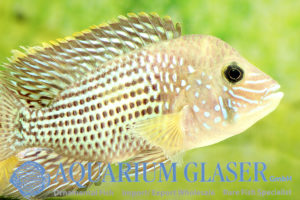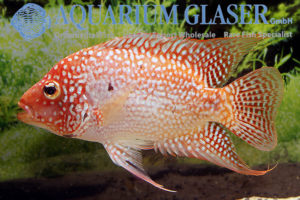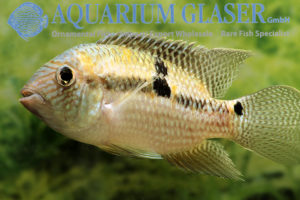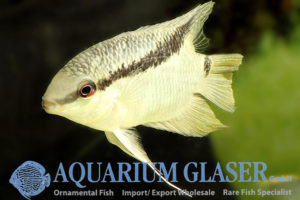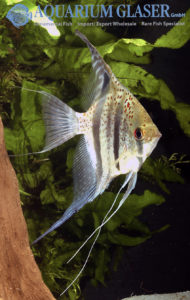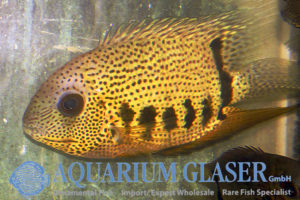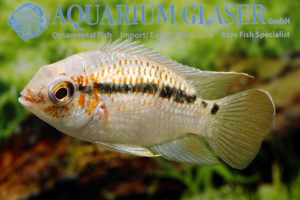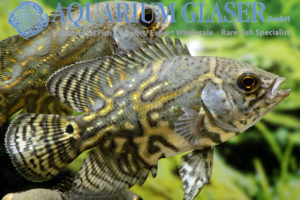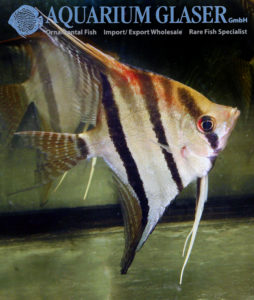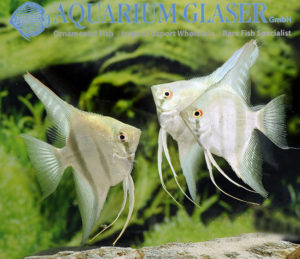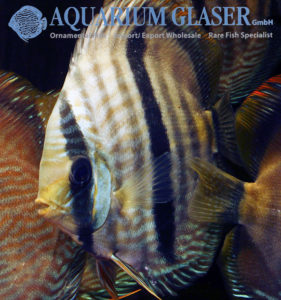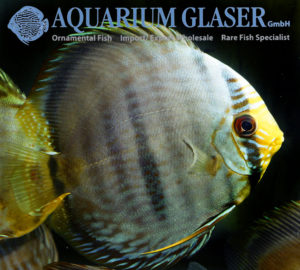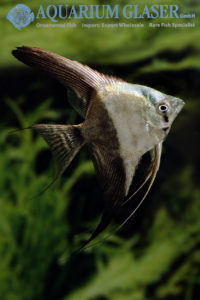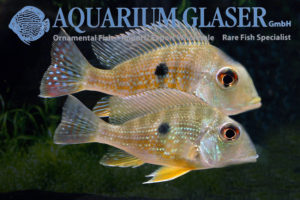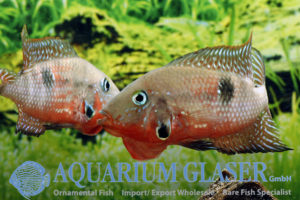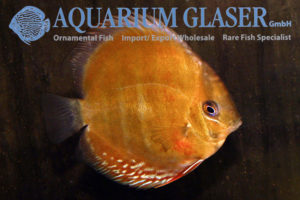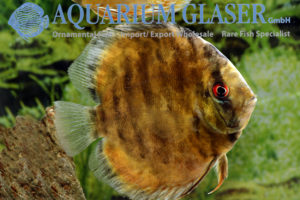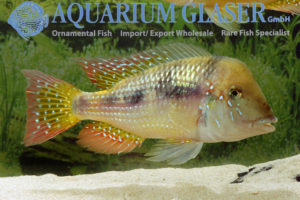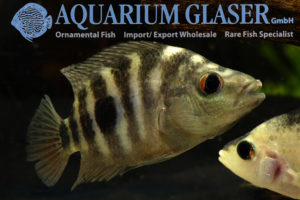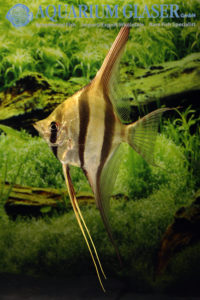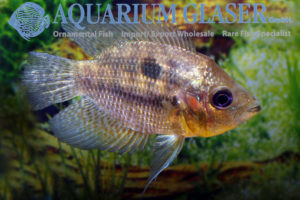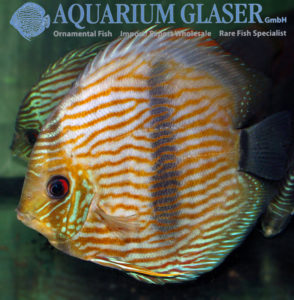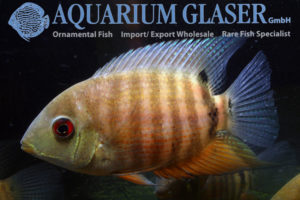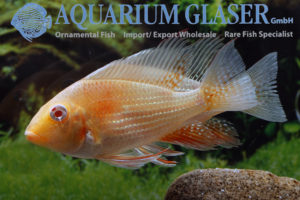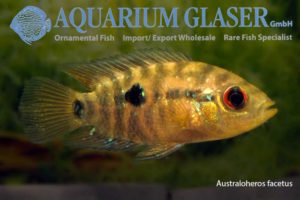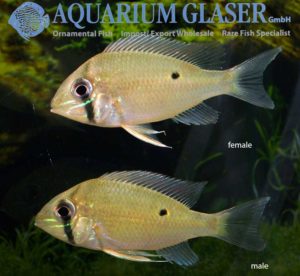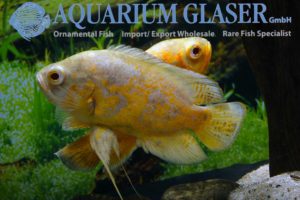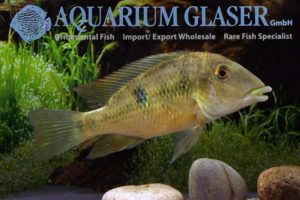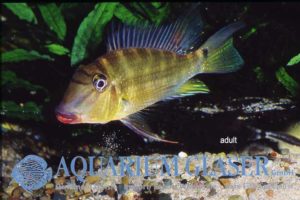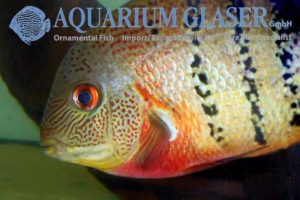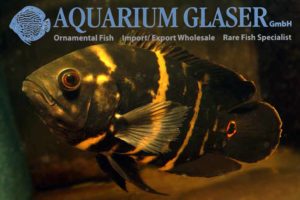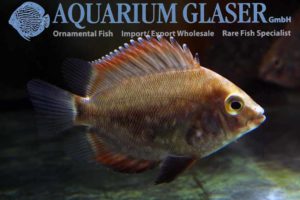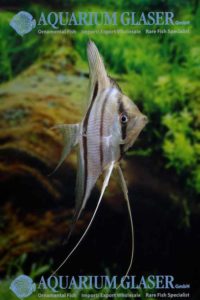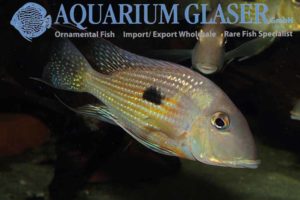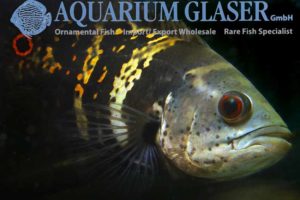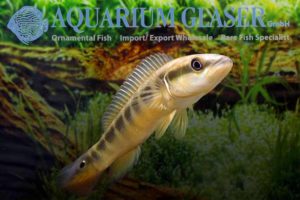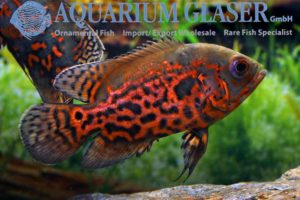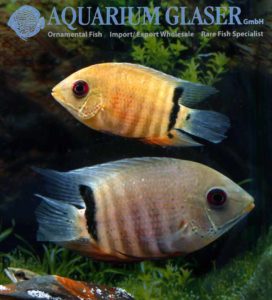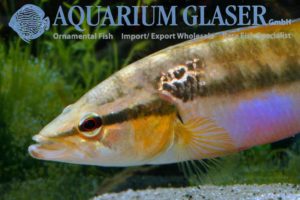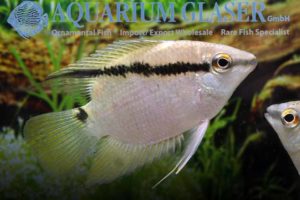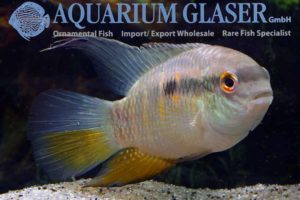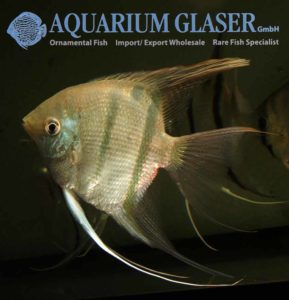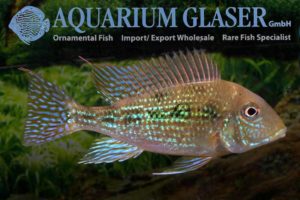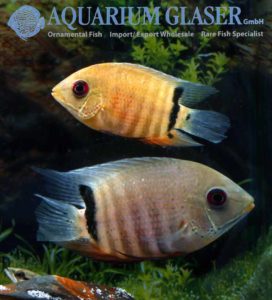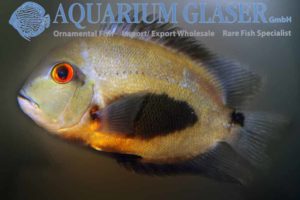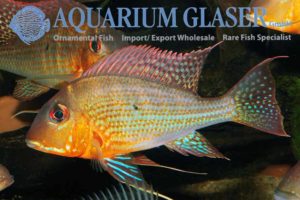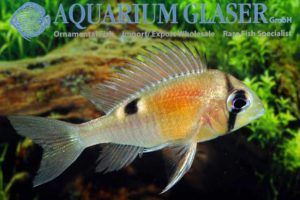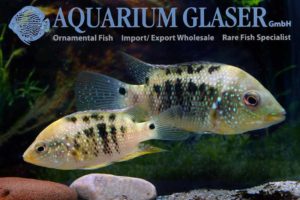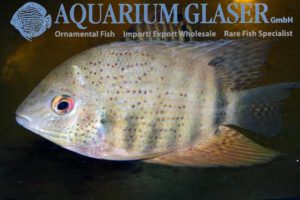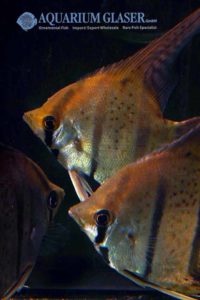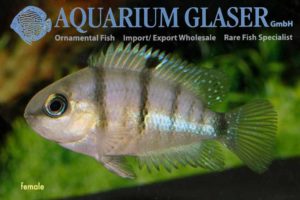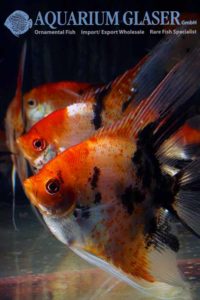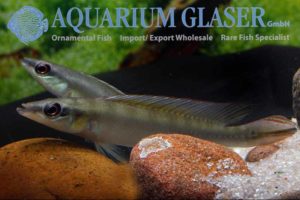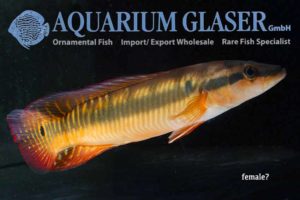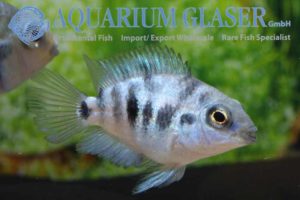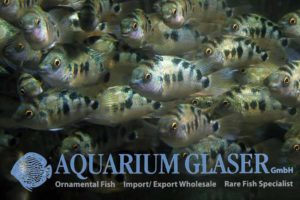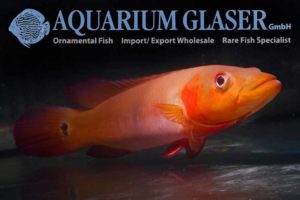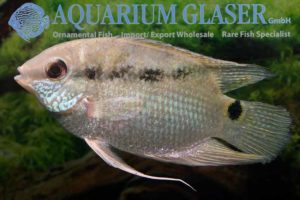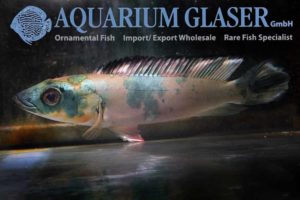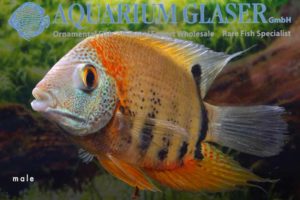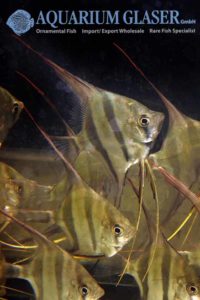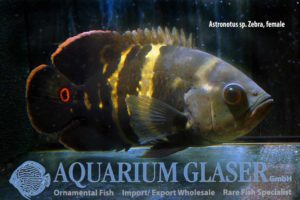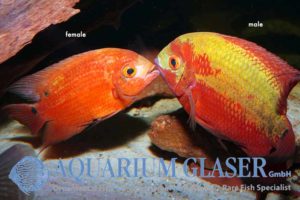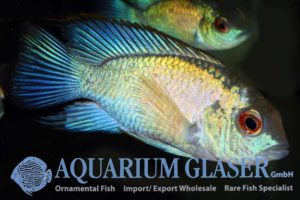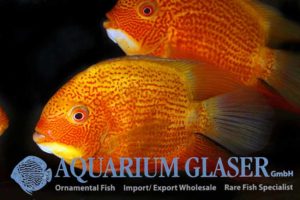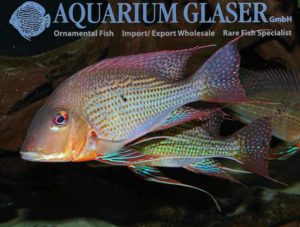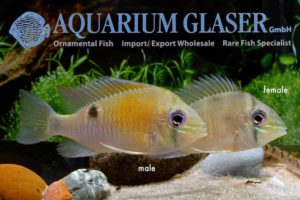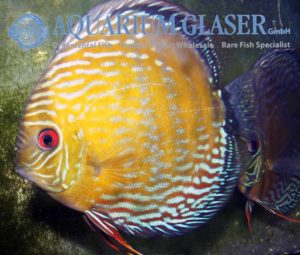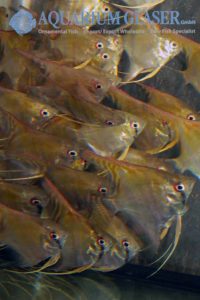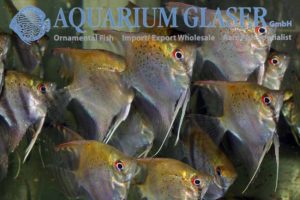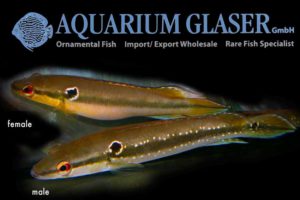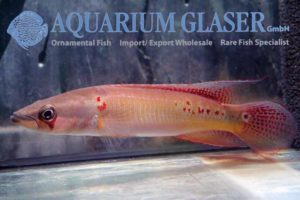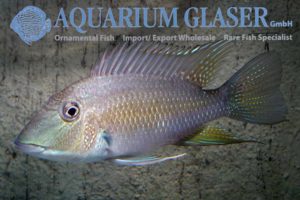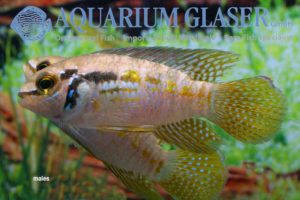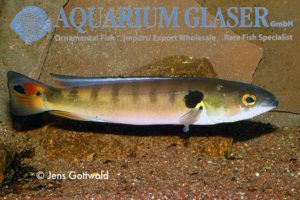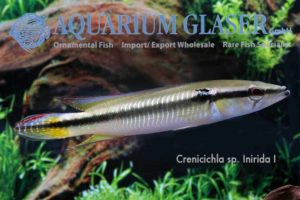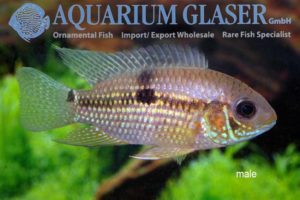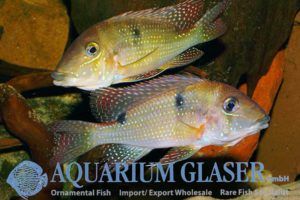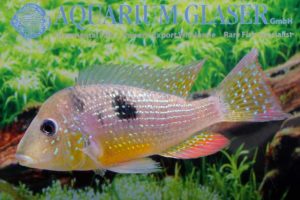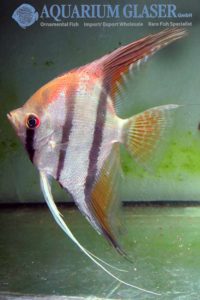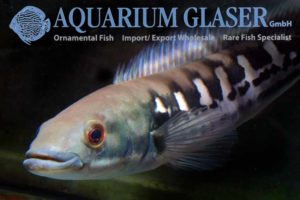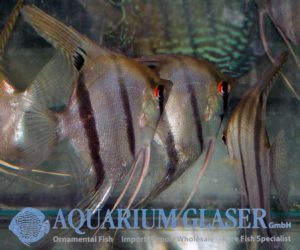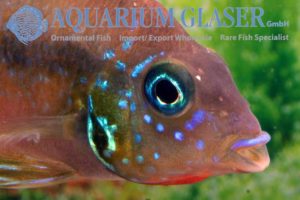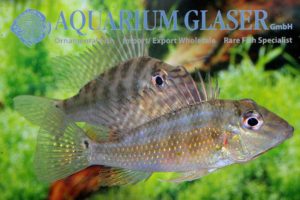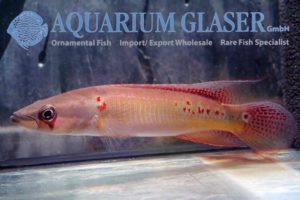Once colourful large cichlids were so popular that imports from Ecuador were organised mainly because of them. On the pacific side of the country live the “Green Terror”, so the then still Aequidens rivulatus named gold seam cichlids were called, and the “Red Terror”, then Cichlasoma festae, today Mesoheros festae. Both species become easily over […]
25e. Perchlike fishes (5): Remaining Cichlids from South and Central America (294)
-
-
Red Texas Cichlid
You may wonder why the title does not contain a scientific name. The reason for this is that the fish we are presenting to you was born from a crossbreed and crossbreeds do not have their own scientific name in zoological naming (unlike in botanical naming). The Red Texas Cichlid, which we offer as B-grade, […]
-
Aequidens sp. Ventuari/Moriche
This beautiful and peaceful, somewhat reserved cichlid comes from Venezuela. It was collected in the Rio Ventuari, at a place where the river has to avoid the mountain Moriche. Mount Moriche is 1216 m high. Aequidens sp. Ventuari/Moriche is undoubtedly closely related to A. metae and becomes about 20 cm long. They are open breeders […]
-
Mesonauta sp. Manapiare
This beautiful flag cichlid (Mesonauta) comes from the Venezuelan federal state of Amazonas and there again from the administrative district Manapiare. Since it cannot be assigned without doubt to one of the Mesonauta species already described, the cichlid enthusiasts currently call it Mesonauta sp. Manapiare. As far as the care is concerned, this fish shows […]
-
Pterophyllum scalare “Guyana Red Dragon”
The wild forms of the angel (Pterophyllum scalare) are enjoying increasing popularity, particularly the variants with locality information. Surely they are also cultivated; so come (or came, because there are currently hardly any exports from there) e.g. in wild catches from Guyana again and again especially many red spotted specimens. And who would blame the […]
-
Heros notatus BRAZIL WILD
We have received wonderful Heros notatus from Brazil. A typical feature of this species are the dark spots in the lower half of the body. As with all Heros the sexes differ by the head colouring, however, it is not always easy to distinguish a strongly coloured female from a male standing far below in […]
-
Krobia xinguensis
This pretty cichlid has been described scientifically only in 2012. Up to that time it was known among hobbyists under the name of Krobia sp. “Xingu Red Head”. This nice relative of Aequidens is the ideal cichlid species for beginners, because it is one of the most peaceful species of cichlid at all. Besides this […]
-
Pterophyllum „Santa Isabel“
We can offer just wonderful, young adult German bred offspring of the famous Santa-Isabel-Angel, which differs clearly from other wild collected angels by its attractive red coloration at the front-back. The animals are descendants of fish that we were able to import as wild catches some years ago (see: https://www.aquariumglaser.de/en/fish-archives/fantastic_pterophyllum_scalare_santa_isabel_arrived__en/). Especially worth mentioning is – […]
-
Astronotus ocellatus Colombia
We obtained very nice juveniles of the Oscar from Colombia. In contrast to the adults the juveniles are strictly schooling fish. In case of a real or imaginary danger the fish school performs a kind of globe. This behaviour also explains the otherwise illogical attractive pattern. In a school this pattern works as a camouflage, […]
-
Pterophyllum scalare Santa Isabel
We received wonderful wild collected angelfish from the municipality of the city Santa Isabel at the Rio Negro. Like many other fishes from that area – mainly discus and Apistogramma – the angels show a high degree of red coloration on the body. The reason for that phenomenon is unknown to us. The water in […]
-
Pterophyllum scalare „Belem Sky Blue“
In the year 2015 along with an import of stingrays from Belem, Para, Brazil an angelfish was imported that was unknown to us until then. Already in 2016, in the F1 generation, a few blue mutants with a red iris could be selected. These blue angels from wild parents formed the basis of the selective […]
-
Symphysodon discus Blue Head Tumbira
Here, as promised, another remarkable Heckel variety we currently have in stock: Blue Head Tumbira. One should not think that every specimen of that variety has a solid blue opercle; Tumbira (the name refers to a Tukano community at the bank of the Rio Negro, below Sao Gabriel de Cachoeira) are still wild collected discus […]
-
Symphysodon discus „Heckel Nova Olinda“
We are now in the last third of the current discus season. A particular charakter of this season is the comparably great number of extremely beautiful Heckel discus. We currently have a number of varieties in stock and want to feature them for you. But of course it is not that easy to take pictures […]
-
Pterophyllum scalare „Bicolor Blue“
We can offer this brandnew sport of the Angelfish (Pterophyllum scalare „Bicolor Blue“) for the very first time now. The animals still differ individually in respect of pattern, but especially the front back of all specimens is already blue. The breeder guaranteed us that the parents are full blue bicolor with a real intensive colour. […]
-
Geophagus cf. abalios
Currently we have as well larger wild collected specimens and bred ones in stock. G. cf. abalios is a beautful, ovophilous mouthbrooider and originates from Venezuela. The fish have bred in our showroom. At that time they had a total length of about 8 cm, so we initially thought they would represent a dwarf variety. […]
-
Thorichthys meeki
The Firemouth (Thorichthys meeki, formerly Cichlasoma meeki) originates from Mexico and belongs to the most popular cichlids at all. This popularity is not at least due to the impressive face mask of the species. No other species of cichlid shows in such perfectness the bottom of the mouth and the deep red skin that covers […]
-
Madeira-Discus arrived!
There are so many varieties of discus known, but none of the wild collected fish are as variable as the ones from the Rio Madeira. Basically speaking, the Madeira discus is a brown-blue one. The brown morphs of that variety very often exhibit a high degree of red and/or yellow colour on the body, while […]
-
A little sensation: the first documented OB discus!
A few weeks ago we received a shipment of hald grown wild collected discus via Manaus. The animals acclimatised very well. As soon as they showed the normal coloration we found that there was one very special animal among them. It was blotched. Initially we thought that the animal would be sick, but it feeds […]
-
Gymnogeophagus caaguazuensis
We received wonderful wild collected specimens of this mouthbrooding cichlid (the females orally broods the larvae and young fry) from Paraguay. This species attains a maximum length of about 9 cm only (standard length, with the caudal fin the maximum length is around 12 cm) and thus is one of the smallest members of the […]
-
Amphilophus xiloaensis
In the lakes of Nicaragua a group of cichlids evolved, which is very interesting from a biological point of view: the Midas cichlids. Formerly they were classified only in two or three variable species within the catch-all genus Cichlasoma: Cichlasoma citrinellum, C. labiatum, and C. zaliosum. Nowadays they are placed in the genus Amphilophus. These […]
-
Wonderful bred Altum angels available!
The Altum angel (Pterophyllum altum) is extremely demanding during the rearing period. If the breeder makes even a minor mistake in respect of water quality or the food this results at once in a life-long deformation of the fish. These gnarled ventral fins, crooked anal fins or defects of the operculum are not heritable; so […]
-
Chaetobranchopsis australis
Here it is: the cichlid with the probably most interesting mode of feeding from Paraguay! Chaetobranchopsis australis is specialized in feeding small planktic organisms. The up to 12-14 cm long fish swallows water like a vacuum cleaner and sieves the plankton with long gill rakers out of it. Obviously at the time of our importation […]
-
Discus Heckel Cross Jatapu
The high season for wild collected discus starts around October and ends in April. Nevertheless, good wild collected discus are available the whole year throught! Some varieties are in general very rarely offered, a good example are the so called Heckel Cross from the Rio Jatapu. They are real beauties! The out-of-season summer discus have […]
-
Heros liberifer German bred
The mouthbrooding species of Heros from Venezuela has finally a widely accepted scientific name: Heros liberifer. Please see http://www.aqua riumglaser.de/en/fish-archives/the_mouthbrooding_heros_from_venezuela_a_new_species_heros_liberifer_en/ for detailed information on that case. From time to time we can offer beautiful, 10-14 cm long German bred specimens of that rare fish. For our customers: the animal has code 682945 on our stocklist. Please […]
-
Acarichthys heckelii Albino
We received this extraordinary and beautiful sport of Acarichthys heckelii from Taiwan. A. heckelii is a comparatively large species of cichlid that can attain over the years a total length of more than 20 cm. And the fish becomes more and more beautiful with every year! The species is very peaceful. Aquarium maintenance is comparable […]
-
Chanchitos
The very first species of cichlid that was ever kept in private aquaria was the Chanchito. At that time – in the year 1894 – the species was classified as Heros facetum. Later it was transferred to Cichlasoma, nowadays it is placed in the comparatively new genus Australoheros. Initially it was thought that there would […]
-
Biotodoma wavrini BRAZIL
There are two accepted species of Biotodoma: B. cupido and B. wavrini. Both differ basically by the position of the lateral blotch, which is positioned above the upper branch of the lateral line in B. cupido and below the upper branch of the lateral line in B. wavrini. Biotodoma cupido is widely distrubuted in South […]
-
Astronotus ocellatus Oscar Lemon
If one likes artifical sports or not is a matter of taste. But these sports are in any case interesting, because they show the genetic potential of a species. So finally men-made sports give hints even for the scientists working exlusively in the field how to distinguish local populations from different species. The Lemon Oscar […]
-
Geophagus pellegrini
Sadly we can offer this beautiful mouthbrooding cichlid from Colombia only very rarely; the last time we had it in stock was 5 years ago. Now we had the opportunity to import this animal. They originate from the Chocó region in Colombia, located in the West of the country. The main river of the Chocó […]
-
Satanoperca rhynchitis
We received beautiful German bred specimens of this rare eartheater. Until the species has been described in 2012 under the name of Satanoperca rhynchitis it was known in the hobby as Satanoperca sp. “Red Lips”. The fish develop the pretty red lips only when adult, so we add a picture of an adult specimen to […]
-
Heros sp. Curare
For the first time ever we were able to import this splendid species of Heros. Reportedly the animals have been collected in the Rio Curare (name). However, we haven´t eard of a Rio Curare so far. We think the fish have been collected in the Rio Ventuari. The fish are extremely colorful; all other features […]
-
Astronotus cf. crassipinnis
There is no other genus of larger cichlids from South America that is so poorly understood as the oscars (Astronotus). Currently only two species are widely accepted, namely A. ocellatus and A. crassipinnis. However, there do exist a lot of more species as can be easily observed with the bare eye. We were able in […]
-
Uaru amphiacanthoides, bred
Only very view species of cichlid have such a drastic change of coloration during growing like Uaru amphiacanthoides. We can offer currently very nice bred ones. Uaru are close relatives of the discus. Like discus they wear the dorsal fin almost always spread. However, Uaru are mainly vegetarians. For more information and pictures of adult […]
-
Pterophyllum scalare WILD Rio Xingu
We received very nice wild collected angels from the Rio Xingu in Brazil. The animals are “real” P. scalare with pointed snouts. They will most probably grow up to impressive, large fish. For our customers: the fish have code 699853 on our stocklist. Please note that we exclusively supply the wholesale trade. Available in limited […]
-
Geophagus sp. Aporema
Aquarium Glaser obtained in spring 2014 a boxed that contained a mixed group of Geophagus, which belonged to three different species. Among them were seven specimens that could not be applied to any known species of Geophagus so far. The fish were 7-8 cm long. Over the time the grew up to gorgeous, about 20 […]
-
Astronotus zebra Tapajos
Again we were able to import a small number of this splendid wild form of the Oscar. For more informations, please see http://www.aquariumglaser.de/en/fish-archive/southamerican-cichlids-en/Large_wild_collected_Zebra_Oscars_arrived__en/ For our customers: the fish have code 633426 on our stocklist. Please note that we exclusively supply the wholesale trade. Available in very limited numbers only! Text & photos: Frank Schäfer
-
Crenicichla semifasciata
Formerly the pike cichlids were splitted in two genera. Batrachops and Crenicichla. Batrachops were the rather blunt-headed species. Nowadays this classification is not accepted anymore and Batraochops seen only as a synonym of Crenicichla. However, hobbyists have not forgotten the old name… One of these blunt headed species is Crenicichla semifasciata from Paraguay. The attractive […]
-
Astronotus ocellatus Roter Tiger Oskar
Only a Red Tiger Oscar… The man-made sport “Red Tiger Oscar” from Astronotus ocellatus is very common in the ornamental fish trade. Oscars are large cichlids that should be kept only in really large tanks. Here they are very nice pets with a great personality. However, we often do not look very intensive on such […]
-
The mouthbrooding Heros from Venezuela: a new species! Heros liberifer
At least from 1992 on Heros have been exported from Venezuela that were thought – according to scientific and hobby publications – to belong to the species Heros severus Heckel, 1840. In 1994 the aquarium community learned fascinated the fact that these “real” H. severus (all other Heros in the hobby belong to different species […]
-
Crenicichla edithae
We received this beautiful, medium-sized (around 15 cm) pike cichlid from Paraguay. Our fish represent the form that is depicted as Crenicichla cf. edithae in Stawikowski & Werner (2004: 140). Occasionally Crenicichla edithae is regarded as a synonym of C. lepidota. C. edithae has been described scientifically in 1991 by Alex Ploeg for his wife […]
-
Mesonauta acora Tocantins
We receved very interesting and very pretty flagcichlids (Mesonauta) from the Rio Tocantins in Brazil. A very special feature of these fishes is the fact that the basic pattern is extremely variable. Usually this dark basic pattern, which is shown by the fish mainly when they are stressed or excited, is species-specific. However, in this […]
-
Laetacara fulvipinnis
Only very rarely this beautiful dwarf cichlid becomes imported. Nevertheless it is known in the hobby for quite a long time. Since 1978 it was named “Aequidens sp. Orange Fin”, later, after the splitting of Aequidens and Laetacara in separate genera, Laetacara sp. “Orange Fin”. The scientifical valid description appeared only in 2007, when Staeck […]
-
Pterophyllum “dumerili”
Pterophyllum “dumerili” We received really breathtaking beautiful angels belonging to the species Pterophyllum leopoldi, among them animals in show-size. On our stocklist the fish are named P. dumerili. Although we know of course that – technically speaking – P. dumerili is only a synonym of P. scalare and our fish belong to the properly described […]
-
Geophagus mirabilis
This beautiful species of eartheater is known in the aquarium hobby since the year 2009. It is endemic in the Rio Aripuana. So it was called initially Geophagus sp. “Aripuana”. The scientific description of the species appeared much later, in january 2015. Now the correct scientific name is Geophagus mirabilis. The specific name, mirabilis, means […]
-
Heros severus wild
Many aquarists know this beautiful cichlid by name, but it is only rarely found in the trade. Wild collected specimens are even rarer. We currently received wild collected specimens from Venezuela. They just start to differentiate sexually and are 7-10 cm long. Eye-spot cichlids can become as large as 20 cm. They are comparatively peaceful […]
-
Uaru amphiacanthoides SANTAREM
Once more we were able to import four wonderful specimens. They have 16-20 cm total length. One specimen, most probably a male, is obviously in mood for breeding: it reacts quite harsh against the photographer! For our customers: the fish have code 688496 on our stocklist. Please note that we exclusively supply the wholesale trade. […]
-
Geophagus cf. altifrons „Rio Araguari“
At the first glimpse one would doubtless place this fish to G. altifrons. However, there are differences. Up to a length of about 10 cm this new variety exhibits exclusively a pattern of vertical double-bars and has a comparatively large lateral spot. The dark zone between operculum and lateral spot, which is so characteristic for […]
-
Biotodoma cupido COARI
Coari is one of the largest cities in the Brazilian state of Amazonas. From the hobbyist´s point of view, Coari is famous for its wonderful Green Discus. Now we received for the first time ever Biotodoma from Brazil which were said to have been collected nearby Coari. Even immediately after the importation the fish showed […]
-
Cichlasoma ornatum
Does something like mythical fish still exist? If so, Cichlasoma ornatum from Colombia and Ecuador for sure belongs to that category. Despite the fact that the species is known to science since 1905 already, only very few specimens ever swam in the tanks of enthusiasts in Europe and the US. Most probably not even a […]
-
Heros cf. efasciatus Japaueri
We received from Brazil beautiful wild collected Heros. According to our supplier the fish have been collected in the Rio Negro in the municipal Japaueri. The most obvious difference to other varieties of Heros are the red spots all over the body. Besides this the new imported Heros obviously become sexually ripe quite early. Our […]
-
Pterophyllum wild “leopoldi Peru spotted”
We received two species of wonderful, large, wild collected angels from Peru. One of them is traditionally called “Pterophyllum leopoldi” in the hobby. It has a reddish back and a number of red spots on the flanks. The name, however, bases on a mis-identification. The “real” P. leopoldi originates from Brazil and is in truth […]
-
Cryptoheros cutteri
We received very nice German bred specimens of this smaller cichlid from Honduras. Despite the comparatively small size – males obtain a maximum length of 13 cm, females always stay smaller – one should not keep these cichlids in small tanks. They have a very vivid temper, especially when they care for the offspring. The […]
-
Scalare Red Devil Show Size
We received 50 gorgeous, fully grown Red Devil Angels. The fish are German bred ones. Our opinion is: more colour is impossible! For our customers: the fish have code 697565 on our stocklist. Please note the we exclusively supply the wholesale trade. Text & photos: Frank Schäfer
-
Crenicichla regani Alenquer
The pike cichlids (Crenicichla) represent the most species-rich genus of cichlid at all. More than 130 species have been described. How many of them are valid is subject of discussions, but the number for sure increases to over 90. Some species become pretty large, more than 30 cm, but there are also real dwarf cichlids […]
-
Crenicichla zebrina
Does there exist anything like a dreamfish even in our days? Well, at least Crenicichla zebrina from Venezuela is a hot candidate! We were able to import two specimens of this top rarity which have a length of 15-20 cm. So far no external features are known for that species to separate males from females. […]
-
Amatitlania sp. Honduras Red Point
The Convict cichlid (Amatitlania nigrofasciatum, formerly Cichlasoma, Archocentrus or Cryptoheros nigrofasciatus) was for a long time one of the most popular species of cichlid in the aquarium. Nowadays it becomes rather rarely seen. Instead of that species another Amatitlania appreared some years ago on stage, named Amatitlania sp. “Honduras Red Point”. These fish seem not […]
-
Amatitlania sp. Honduras Red Point
Recently we could introduce to you this pretty dwarf cichlid that belongs to the closer relationship of the Convict cichlid (Amatitlania nigrofasciatum, formerly Cichlasoma n.), see http://www.aquariumglaser.de/en/news/Amatitlania_sp_Honduras_Red_Point_en/Now we obtained again specimens from our proved breeder. For our customers: the animals have code 674452 on our stocklist. Please note that we exclusively supply the wholesale trade. […]
-
Crenicichla sp. Tapajós
At the beginning of this week we introduced to you the dwarf cichlid Teleocichla proselytus from the Rio Tapajós (see http://www.aquariumglaser.de/en/news.php#1040). A close relative, but much, much bigger is the gorgeous red Crenichichla sp. Tapajós that originates from the same river. The species is not described scientifically yet. Females (sadly too shy for a good […]
-
Mesonauta festivus
We received from Brazil very nice, wild collected flag cichlids. M. festivus is usually not kept due to its coloration, which is not very spectacular, but due to the interesting and peaceful behaviour. But the animals that reached us now have a very interesting, blue pattern in the face. The scales also show an attractive […]
-
Crenicichla lugubris Jutai
Once more we were able to import some specimens of this gorgeous large cichlid from the Jutai region. This time the shipment contained one male with an extraordinary marble pattern. For more informations please click http://www.aquariumglaser.de/en/news/Crenicichla_lugubris_Jutai_en/ For our customers: the fish have code 670746 on our stocklist. Please note that we exclusively supply the wholesale […]
-
Heros cf. efasciatus Red Shoulder
We received wonderful wild collected specimens of this extraordinary species from Peru. Currently the fish are 9-12 cm long. Experts are still debating whether these fish belong to the species Heros efasciatus or to a scientifically still undescribed species of Heros. But all agree that they represent the most attractive Heros at all. Males can […]
-
Altum angels: bred ones available!
We obtained very beautiful German bred Pterophyllum altum. The “Orinoco” strain is characterized by the very good shape of the body and a high degree of red in the fins. For our customers: the fish have code 698303 on our stocklist. Please note that we exclusively supply the wholesale trade. Text & photos: Frank Schäfer
-
Large wild collected Zebra Oscars arrived!
The Oscar (Astronotus ocellatus) is by far the most popular species of large cichlid from South America. This is not only because it is so splendid coloured, but also due to its behaviour: the fish becomes much larger than 20 cm, but is of calm nature and can thus be kept and bred properly in […]
-
Hypselecara temporalis OYAPOC
The Emerald cichlid has become a bit out of fashion. This is a quite sad thing, for this impressive large cichlid – males can become up to 30 cm long, females always stay much smaller – is one of the most beautiful species of cichlid of South America. For the first we can offer now […]
-
Aequidens (Nannacara) Neon Blue
For all aquarists that feel that Electric Blue Rams are too delicate and Rocio octofasciata “Blue Dempsey” too aggressive: here is an alternative breed from Singapore. The fish are sold under the name of “Nannacara Neon Blue”. Despite the fact that we are quite sure that these fish do not belong to the genus Nannacara […]
-
Heros severus Gold-Red-Spot
We obtained gorgeous, fully grown eyespot cichlids of that sport from a German breeder who kept them in a 1.800 liter tank. These fish are real eyecatchers! For our customers: the animals have code 661617 on our stocklist. Please note that we exclusively supply the wholesale trade. Available in limited numbers only! Text & photos: […]
-
Geophagus altifrons Curua Una
All species of Geophagus are gorgeous fish, but G. altifrons – the species can be recognized by the shape of the lateral spot, which is always smaller than the diameter of the eye – is one of the most beautiful of all. We currently can offer German bred specimens which belong to the population of […]
-
Biotodoma cupido Peru
The small cichlid Biotodoma cupido – the species can attain a maximum length of about 12-15 cm, but is sexually mature already at 6-8 cm total length – is probably the species of cichlid with the widest distribution in Amazonia. However, experts are merrily discordant wether all the different looking populations represent only varieties of […]
-
Discus Royal Blue Nhamunda Maracanha
We continue our journey through the magical world of recently imported wild collected discus with these magnificent animals. Available in very limited numbers only! You will find a small video of the fish on our facebook page: https://www.facebook.com/media/set/?set=vb.119893808211837&type=2 For our customers: the animals have code 731358 on our stocklist. Please note that we exclusively supply […]
-
Scalar Amapa Red Back
Code: 699668
-
Scalar Essequibo
It is a bit amazing, but the wild varieties of the angel fish appeared in the focus of aquarists only recently, despite the fact that angelfish are among the most popular oramental fish at all. A very pretty variety with many re spots occurs in the Essquibo river in Guyana. We get them as German […]
-
Crenicichla sp. Inirida IV
For the first time ever we were able now to import another species of pike cichlid from the surroundings of Puerto Inirida in Colombia. This species is illustrated and described in the German book “Die Buntbarsche Amerikas Bd. 3” by Rainer Stawikowski and Uwe Werner as Crenichla sp. Inirida IV. This is also a very […]
-
Crenicichla sp. Inirida III (= Fire Spot)
Once more we were able to import a small number of this extraordinary beautiful pike cichlid. Many specimens are obviously fully grown already, the fish have sizes of 8 – 15 cm. For our customers: the fish have code 673583 (8-10 cm), 673584 (10-12 cm), and 673585 (12-15 cm). Please note that we exclusively supply […]
-
Satanoperca jurupari Tocantins
We received very nice, approximately 15 cm long Satanoperca jurupari from the Rio Tocantins in Brazil. This eartheater is only seldom available. For our customers: the fish have code 678506 (12-15 cm) and 676507 (14-17 cm) on our stocklist. Please note that we exclusively supply the wholesale trade. Available in limited numbers only! Text & […]
-
Laetacara araguaiae
Finally we were able to import once more this charming dwarf cichlid. The fish was known in the hobby under the name of Laetacara sp. “Buckelkopf” ( = humphead) before the scientific description. For more informations, please click http://www.aquariumglaser.de/en/news/Laetacara_araguaiae_en/ For our customers: the animals have code 603002 on our stocklist. Please note that we exclusively […]
-
Crenicichla sp. Jatapu
We were able to import a very special pike cichlid, belonging to the closer relationship of Crenicichla strigata/marmorata/lenticulata. Only one pair reached us, which is currently 20-25 cm long and thus not fully grown yet. According to the well known specialist for pike cichlids, Jens Gottwald (who supplied us a nice picture of a fully […]
-
Crenicichla sp. Inirida I and III
We received in very small numbers these beautiful pike cichlids from Venezuela. Crenicichla sp. Inirida III has the special feature of red spots in the pattern (see also http://www.aquariumglaser.de/en/crenicichla-sp-fire-spot-venezuela–sp-inirida-iii_de_1495.html for the picture of an adult male). In Crenicichla sp. Inirida I the shape of the shoulder spot is unique and the males develop a very […]
-
Aequidens patricki
This cichlid originates from a comparatively small collecting site in Peru. That´s why Aequidens patricki is imported only very occasionally. In the wild, the species lives in soft and acidic water. However, the species is very hardy and adapts well to variable water conditions in the aquarium. Another positive fact is that this species is […]
-
Geophagus harreri
For the first time ever we can offer this pretty eartheater. The parents originate from Suriname (exactly: the Tapanahoni river. However, the species occurs also in other rivers of Suriname, like the Maroni river, for example). The fish prefer a moderate to strong current, but change to habitats with less current for breeding. Keeping conditions: […]
-
Gymnogeophagus caaguazuensis
We received wonderful wild collected specimens of this mouthbrooding cichlid (the females orally broods the larvae and young fry) from Paraguay. This species attains a maximum length of about 9 cm only (standard length, with the caudal fin the maximum length is around 12 cm) and thus is one of the smallest members of the […]
-
Fantastic Pterophyllum scalare Santa Isabel arrived!
Yesterday reached us wonderful wild collected angels from Santa Isabel. The picture has been taken from one of the fish that arrived yesterday! The fish have a beautiful coloration and are in a perfect condition. For more information see http://www.aquariumglaser.de/en/pterophyllum-scalare-santa-isabel_de_1487.html For our customers: the fish have code 699835 on our stocklist. Please note that we […]
-
Crenicichla marmorata Lago Maracana
Lago Maracana is famous among aquarists for its beautiful discus. We now received for the first time ever two wonderful Crenicichla marmorata from that lake. The fish are currently 20-25 cm long. For our customers: the animals have code 671066 on our stocklist. Please note that we exclusively supply the wholesale trade. Text & photos: […]
-
Pterophyllum sp. Jatapu
Breathtaking, large, wild collected angelfish originating from the Rio Jatapu in Brazil arrived on wednesday. These animals have a very distinct black spot in the dorsal fin. We have never seen before such markings in angelfish. Possibly the angels represent a new, undescribed species. Even though the photo can – of course – not yet […]
-
Thorichthys-Week at Aquarium Glaser
The genus Thorichthys originates from Central America. Formerly the fish were grouped in the catch-all genus Cichlasoma. The best known species is the fire mouth cichlid, Thorichthys meeki. All Thorichthys are very beautiful. Compared with other cichlids, Thorichthys are also quite peaceful. Currently we have a good number of species of Thorichthys in stock, which […]
-
Satanoperca rhynchitis
We received beautiful German bred specimens of this rare eartheater. Until the species has been described in 2012 under the name of Satanoperca rhynchitis it was known in the hobby as Satanoperca sp. “Red Lips”. The fish develop the pretty red lips only when adult, so we add a picture of an adult specimen to […]
-
Crenicichla sp. Fire Spot Venezuela (= sp. Inirida III)
Two days ago we were able to import a single specimen of pike cichlid , which we have never seen before. The animal for sure belongs to the rambling relationship of Crenicichla saxatilis; however, no scientific description on a species exist that has red instead of black markings on the body. Our specimen – most […]
New: Clown-Angels



For
the first time ever we obtained from one of our breeders so called
“Clown-Angels”. The attractive fish look much alike the leopard angels,
but the spots are restricted to the hinder two thirds of the body. The
first third of the body is plain, so the contrast to the spotted part is
very strong.



For our customers: the fish have code 694802 on our stocklist. Please note that we exclusively supply the wholesale trade.
Text & photos: Frank Schäfer
Bred Cichla from Southeast Asia

The
cichlids of the genus Cichla are the largest cichlids in South America
and they are regarded as the best food fish at all there. The maximum
size recorded for Cichla is around 75 cm, but usually they attain a
length between 25 and 40 cm. These fish have been kept in aquaria only
very rarely formerly, because they were said to be very sensitive
against transportation. However, nowadays this is no real problem
anymore.






Determination
of species within Cichla was almost impossible until 2006; only very
few species were accepted, but a lot more phenotypes existed. Currently
this is not that difficult anymore thanks due to a revision of the genus
made by Kullander & Ferreira in 2006. But still the juveniles –
these look totally different to the adults and are very similar in the
different species – are tricky to tell apart.


Breeders
in Southeast Asia offer already bred specimens. All these fish are
named “Cichla sp. temensis” by the breeders. However, they belong to at
least two different species. The fish we obtained from Thailand are most
likely Cichla monoculus, while those from Singapore seem really to
belong to C. temensis. But we have decided now to grow some specimens to
find out what they really will become.
For our customers: the fish have code 637003 on our stocklist. Please note that we exclusively supply the wholesale trade.
Text & photos: Frank Schäfer
The fourth Retroculus has been described
In our newsletter from the last weekend we mentioned that besides the three described species of Retroculus also an undescribed one exists. Sadly we overlooked that the undescribed has been in fact described in June this year: Retroculus acherontos from the Rio Tocantins. The species is distinguished from all other species of Retroculus by a hump on the fronthead (visible in specimens from 12-13 cm length) and the fact the the dark spot in the soft part of the dorsal fin is situated in the median part of that fin and not, like in all other Retroculus, near the back. Additional species differences are not visible in live fish.
As far as we know this beautiful fish has not been imported yet. Pictures of freshly captured, living fish can bee seen in the most current issue of Amazonas Magazine (No 61 for September/October 2015).
Literatur: Landim, M. I. , C. R. Moreira and C. A.
Figueiredo (2015): Retroculus acherontos, a new species of cichlid fish
(Teleostei) from the Rio Tocantins basin. Zootaxa 3973 (no. 2): 369-380
Text: Frank Schäfer
Wild collected Oscars from Brazil


Once
more we were able to import four wonderful, large (18-25 cm) specimens
of the Oscar cichlid from Brazil. There is no consensus among scientists
how many species should be assigned to the genus Astronotus. Most
scientists accept only two species, namely A. crassipinnis and A.
ocellatus. Others believe that there are many more species and that the
genus Astronotus is urgently in need of a scientific revision. We think
that the four current imports belong to three different species. So we
do not use scientific specific names here.


A
beautiful pair reached us from the state of Pará. The male has a high
degree of red all over the lower part of the body, whereas in the female
the red colours are restricted basically to the region around the
opercle. We are sure that fish like these were among the ancestors of
the artificial sport called “Red Tiger Oscar”.


Two
other specimens reached us from the Rio Tapajós. They most likely
represent two different species or the sexual dimorphism is extreme in
this population of Oscar. One of the specimens is very slender and has a
nice yellow basic colour. The other specimens reminds us strongly to
the “Zebra” we were able to import last year (see http://www.aquariumglaser.de/en/fish-archive/southamerican-cichlids-en/Large_wild_collected_Zebra_Oscars_arrived__en/), but this time the bright vertical stripes are rather reddish and the animal has a great number of black speckles in the face.


For
our customers: the fish have code 633427 (Tapajós) and 632528 (Pará) on
our stocklist. Please note that we exclusively supply the wholesale
trade.
Text & photos: Frank Schäfer
Discus season started!

Every
year we eagerly await the start of the season for wild collected
discus. Now it has started finally and we received, for example,
breathtaking beautiful Royal Blues from Oriximina (Rio Trombetas), among
them show animals with a length of about 14-17 cm (see photos). But we
also obtained smaller specimens, which are also very beautiful…

For
our customers: the fish have code 731064 (8-12 cm), 731065 (12-15 cm),
731066, and 731076 (14-17 cm) on our stocklist. Please note that we
exclusively supply the wholesale trade.
Text & photos: Frank Schäfer
Brown-red Discus Madeira Nova Olinda do Norte

Madeira
discus are famous for the high degree of red colours for decades
already. Last week we received beautiful, brown discus from the Madeira
region with the additional name “Nova Olinda do Norte”. Besides the nice basic
coloration the pretty light coloured, almost white dorsal fin is worth
mentioning in our newscomers.

For our customers: the fish have code 732014 on our stocklist. Please note that we exclusively supply the wholesale trade.

Text & photos: Frank Schäfer
Pearl cichlids – German bred ones available!

The
Pearl cichlid has been imported and successfully bred in Germany as
early as 1902. In the meantime there were several changes regarding the
name. Formerly known under the name of Cichlasoma cyanoguttatum it is
now a member of the genus Herichthys. It is believed that the large
spotted form, which we can offer right now as German bred ones, belongs
to the species Herichthys carpinte that originates from Mexico, whereas
the small spotted form is thought to represent the “real” Herichthys
cyanoguttatum. The latter is the only native cichlid of the US and the
northernmost species of cichlid at all.


Sadly
Pearl cichlids are almost forgotten nowadays. So we are always glad
when once per year one of our breeders offers us this beautiful fish.
Currently the animals are 4-5 cm long. However, maximum length for the
species reported is about 30 cm. Large specimens are among the most
colorful species of cichlid at all!
For our customers: the fish have code 644502 on our stocklist. Please note that we exclusively supply the wholesale trade.
Text & photos: Frank Schäfer
Discus Brown wild / Cameta

Actually, it is
not the high season for wild collected discus. Nevertheless we obtain
now and then wonderful specimens. Currently we could import Brown Discus
from Cametá situated at the Rio Tocantins. The graceful animals, which
have perfect proportions, show a high degree of red coloration.

For our customers: the fish have code 731905 on our stocklist. Please note that we exclusively supply the wholesale trade.


Text & photos: Frank Schäfer
The discus season has started (2)!

Despite extremly high water levels (four meter over the normal level of the season) the first wild collected discus of the new season came in. They are very beautiful; today, our focus is on the Blue Discus originating from the Madeira River. This particular variety differs much in coloration individually.


For our customers: the fish have code 731195 on our stocklist.


Please note that we exclusively supply the wholesale trade.
We have placed a video of the fish on our Facebook page….just click here!
We would be happy if you “like” it 😉
Text & photos: Frank Schäfer
The discus season has started!
Despite extremly high water levels (four meter over the normal level of the season) the first wild collected discus of the new season came in. They are very beautiful, for example:

Green Discus (Few Red Spot), code 737105

Please note that we exclusively supply the wholesale trade.
Text & photos: Frank Schäfer
Red Back Angels


We received Red Back Angels from a German breeder, which already have currently – at a size of only 3-4 cm – a breathtaking intense coloration. Red Back Angels do exist also in the wild, several populations are known. So this fish is not an artificial sport, but a real wild form.

For our customers: the animals have code 699662 on our stocklist. Please note that we exclusively supply the wholesale trade.
Text & photos: Frank Schäfer
Wonderful large growing cichlids from Brazil
Currently we can offer some top-rarities among the cichlids, wild collected in Brazil.

Chaetobranchus flavescens is a species that feeds mainly on plankton. Despite the wide distribution it is hardly ever imported. So still nobody knows anything on the mode of reproduction in that species. It attains a maximum length of almost 30 cm and gets very pretty extensions on the fins when fully grown.
Chaetobranchus flavescens, 10-12 cm, Code 635505

Oscars are hardly ever offered as wild collected ones. The specimen we currently have in stock originate from the state of Para. Many specimens have very nice red spots.
Astronotus ocellatus Para wild, 9-12 cm, Code 632524


We were able to import a pair of adult Uaru from the vicinity of Santarem. These fish are very impressive and sober.
Uaru amphiacanthoides Santarem, 18-22 cm, Code 688497
Please note that we exclusively supply the wholesale trade.
Text & photos: Frank Schäfer
Bred Altum Angels available!

We received German bred Altum Angels. The fish are very healthy and stable. Currently they are 6-7 cm long.
For our customers: the fish have code 698402 on our stocklist. Please note that we exclusively supply the wholesale trade. Available in limited numbers only!
Text & photo: Frank Schäfer
High season for wild Discus!
 Discus wild HECKEL BLUE/UATUMA
Discus wild HECKEL BLUE/UATUMA
Once more we received a large number of fantastic wild collected Discus. The fish are large, healthy and very stable. Now is the best time to order these fishes, for there is high season in Brazil. This week we recommend especially the wonderful blue Discus from Paraconi (there do not exist only the red ones!) and the gorgeous Heckel from Uatuma.

 Discus wild BLUE COLORFUL/PARACONI
Discus wild BLUE COLORFUL/PARACONI
For our customers: the blue Discus from Paraconi have code 739026, the Heckel from Uatuma code 735206 on our stocklist. Please note that we exclusively supply the wholesale trade.

 Discus wild HECKEL BLUE/UATUMA
Discus wild HECKEL BLUE/UATUMA
Text & Photos: Frank Schäfer





